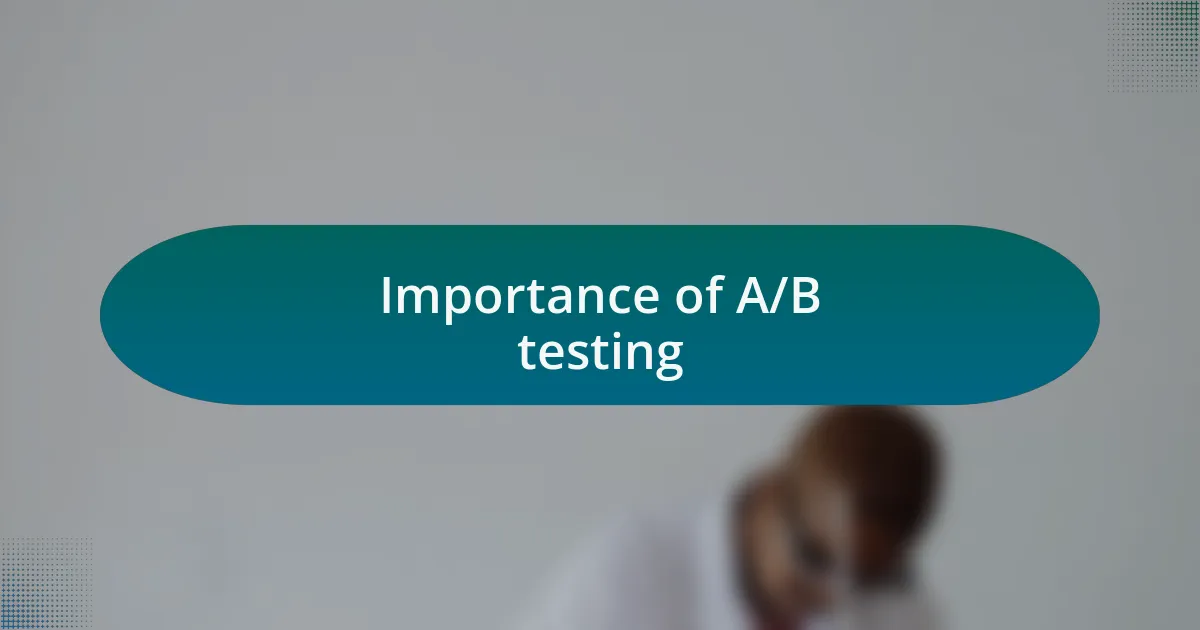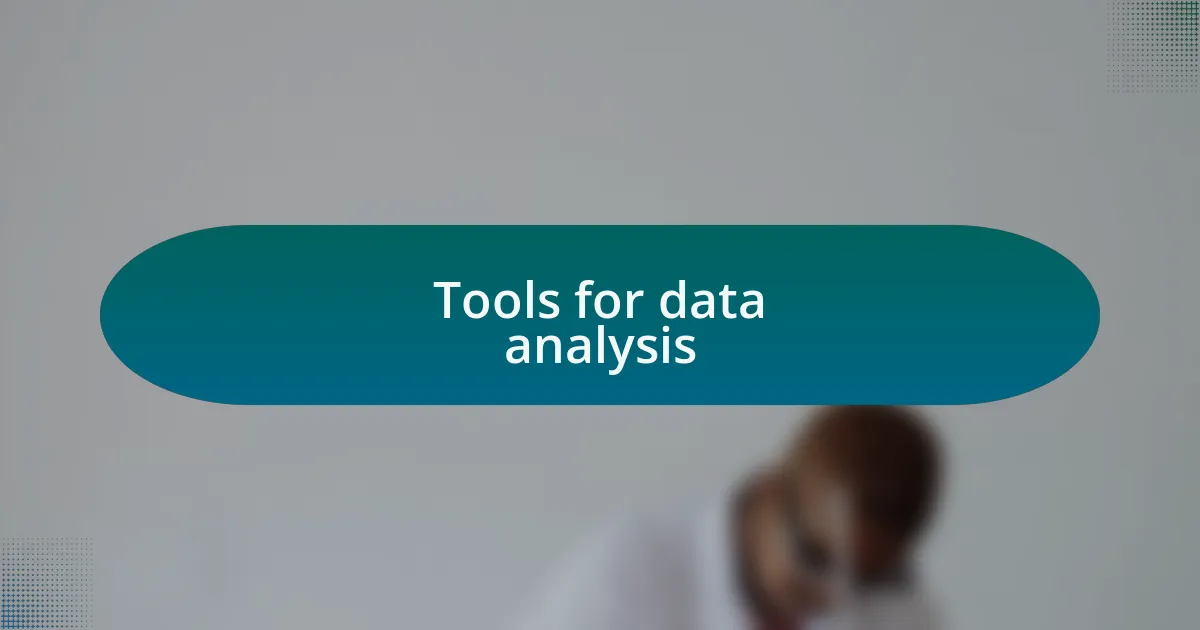Key takeaways:
- A/B testing tools facilitate data-driven decision-making by allowing users to test variations and directly observe their impact on metrics like conversion rates and user engagement.
- Key features to look for in A/B testing tools include ease of use, audience segmentation capabilities, and robust analytics for interpreting results.
- Data analysis and hypothesis testing tools enhance the understanding of A/B test outcomes, providing clarity and fostering better collaboration among team members.
- Popular A/B testing tools like Optimizely, Google Optimize, and VWO enable effective experimentation, leading to significant improvements in user interaction and conversion rates.

Understanding A/B testing tools
When I first stumbled into A/B testing, I was amazed by how these tools could transform the way I approached decision-making on my website. The sheer ability to test two variations against each other and see which performed better was like having a scientific experiment right at my fingertips. Have you ever wondered how small changes can lead to significant results? That’s the power of A/B testing tools.
These tools offer a range of features, from audience segmentation to advanced analytics, which can feel overwhelming at times. I remember feeling lost among the options available, questioning which tool would truly fit my needs. It’s essential to take a step back and consider what specific metrics you want to improve—is it conversion rates, user engagement, or something else?
In my experience, the right A/B testing tool can be a game-changer. I once experimented with the color of a call-to-action button and, surprisingly, the results led to a 20% increase in clicks. That moment solidified my belief in using data to inform decisions rather than relying solely on intuition. It’s fascinating how a simple tool can provide such profound insights into user behavior!

Importance of A/B testing
A/B testing is crucial for any website looking to optimize its performance. I once ran an A/B test on the messaging of my newsletter signup form, and the results were eye-opening. By simply rephrasing the call to action, I boosted subscriptions by 30%. It made me realize just how vital words can be in engaging users effectively.
The importance of A/B testing goes beyond numbers; it’s about understanding your audience. I’ve often found myself asking, “What do my users really want?” When I implemented A/B testing on various designs, the feedback from user behavior was immediate and enlightening. Those insights didn’t just tell me which design was better—they revealed the preferences and needs of my audience, helping shape my future strategies.
Moreover, A/B testing fosters a culture of experimentation. Each test encourages me to step outside my comfort zone and try new ideas. I remember initiating a test to change the layout of my homepage. Initially, I was apprehensive; what if it backfired? Instead, it sparked a delightful increase in user interaction, solidifying my belief that trying new things is essential. Isn’t it fascinating how a structured approach to testing can lead to creative breakthroughs?

Key features to consider
When choosing tools for A/B testing, one critical feature to consider is ease of use. I remember the first time I attempted to set up an A/B test using a complicated platform. The learning curve was steep, and it felt overwhelming. A user-friendly interface can save time and make the process much smoother, allowing you to focus more on analyzing results rather than getting lost in technical details.
Another essential feature is the ability to segment your audience effectively. In my experience, targeting specific user groups can yield significantly different outcomes. For instance, I once divided my test between new visitors and returning ones, and the insights varied dramatically. This segmentation allows you to tailor your strategies finely and ensures that your findings are relevant and actionable.
Lastly, I cannot stress enough the importance of robust analytics capabilities. It’s great to test different variations, but what’s the point if you can’t understand the results? After running a test, I remember staring at a sea of raw data, feeling both excited and a bit anxious. A tool that offers clear visualizations and easy-to-understand metrics can turn that confusion into clarity, enabling you to make informed decisions with confidence. How do you ensure you’re not just guessing at your next move? With the right tools, you can base your decisions on solid evidence.

Tools for data analysis
Data analysis tools are pivotal for making sense of A/B testing results. I vividly recall a time when I relied on complex spreadsheets to analyze my test outcomes. The experience was like searching for a needle in a haystack; it was tedious, and I often questioned whether I was extracting meaningful insights. That’s when I discovered tools that streamline data analysis. They not only provide quick calculations but also allow for easy comparisons, making me feel more efficient and confident in my decisions.
Another preferred tool I frequently turn to is one that integrates machine learning. I was initially skeptical about using algorithms to interpret my data. However, after experiencing a significant increase in the accuracy of my predictions, I was convinced. These advanced capabilities can uncover patterns I didn’t even know existed. It raised an important question for me: If I’m missing these insights without the right tools, how many opportunities am I overlooking?
Moreover, collaboration features in data analysis tools have transformed my workflow. When I worked alongside a colleague to evaluate test results, we often found ourselves stuck in lengthy email threads, struggling to interpret our findings together. After implementing a collaborative tool, we could visualize and annotate data in real time, leading to more productive discussions. Have you ever felt that frustration of miscommunication? With the right analysis tools, those barriers fade away, allowing for richer conversations and better outcome predictions.

Tools for hypothesis testing
Tools for hypothesis testing play a crucial role in validating ideas before diving into full-scale A/B testing. I remember the first time I used a hypothesis testing tool; the clarity it brought to my decision-making was astounding. It felt like shining a flashlight into a dark room—I could finally see the potential pitfalls and advantages of my ideas before investing significant resources.
One particular tool I use often is statistical software that allows for straightforward testing of significance levels. During one project, I encountered conflicting data that challenged my initial hypothesis. Instead of guessing or relying on intuition, the tool enabled me to run a series of tests to quantify my uncertainties. This process not only refined my approach but also heightened my confidence in the outcomes, as I was making decisions based on solid evidence rather than mere speculation.
Furthermore, visualization features in hypothesis testing tools hold immense value for me. I distinctly recall a time when my research team was stuck debating the implications of our data. By utilizing graphical representations, we could easily identify trends and spot anomalies that were otherwise hidden in numbers. Have you ever felt as though you’re debating in circles? That experience taught me the power of visual clarity—sometimes, seeing the data laid out visually can break down barriers in understanding and foster more meaningful conversations among teammates.

My favorite A/B testing tools
When it comes to A/B testing, one tool I can’t live without is Optimizely. I remember diving into a project where every second of user engagement counted. Optimizely made it incredibly easy to set up tests and analyze results in real time. Watching the results roll in was thrilling and gave me a sense of control over the user experience, as I could directly see how small changes impacted engagement. Have you ever felt that excitement when a change you’ve made starts to yield positive results?
Another favorite of mine is Google Optimize. It integrates seamlessly with Google Analytics, which just makes my life easier. One time, I had a hunch that changing the headline on a landing page would boost conversions, but instead of guessing, I set up a quick test. The insights I gathered were eye-opening; seeing user behavior shifted in real-time helped cement my understanding of what really resonates with my audience. It’s moments like these that emphasize the importance of data-driven decisions.
Lastly, I often turn to VWO (Visual Website Optimizer) for its user-friendly interface and powerful capabilities. During a recent project, I faced the challenge of optimizing a complex signup form. VWO allowed me to easily experiment with different layouts and messaging. Seeing the conversion rates change with every iteration was not only gratifying but also reinforced the idea that even minor tweaks can lead to significant outcomes. How often do we underestimate the impact of small changes? This tool consistently reminds me of the value in experimenting and learning from the results.

How I use these tools
Using Optimizely is a game changer for me. When I embarked on a recent project analyzing how button colors affected click-through rates, I felt like a scientist in a lab, eager to uncover truths. The ability to create variations quickly meant I could test my hypotheses without hesitation. Each time I witnessed a spike in clicks, it was like a mini-celebration, reminding me of the decisiveness that A/B testing offers.
In my experience with Google Optimize, I found that running tests could be almost meditative. There was a particular instance when I experimented with different call-to-action prompts. The process required patience, but the moment I noticed a tangible increase in user engagement felt rewarding. I often reflect on how these small adjustments can create a ripple effect. Isn’t it fascinating how users respond when we tune into their preferences?
VWO has proven invaluable during challenging projects, particularly when fine-tuning navigation menus. I once struggled with a high bounce rate, and after applying various modifications through VWO’s easy interface, I gradually saw improvements. It taught me patience in experimentation—sometimes the best insights emerge when we allow the data to speak for itself. Have you experienced those moments of clarity when you finally understand what your users truly want?